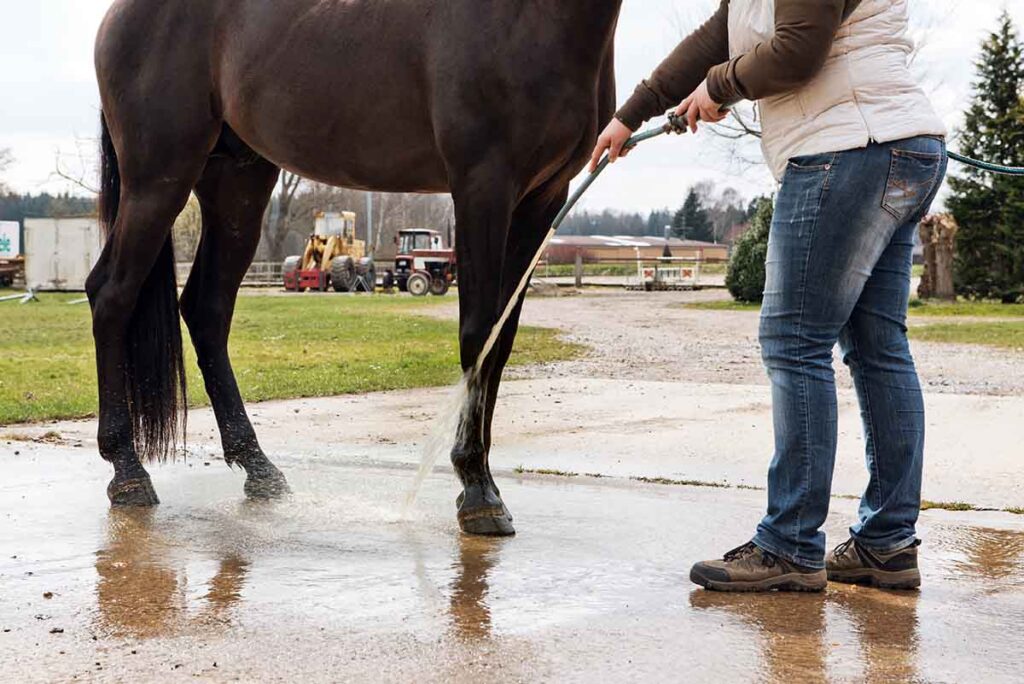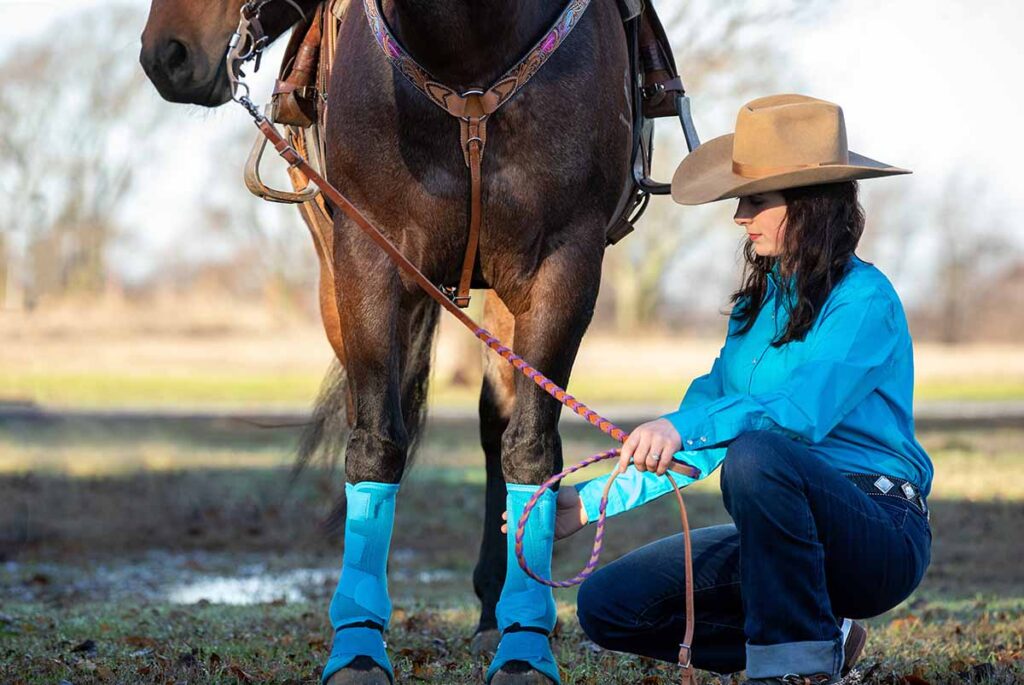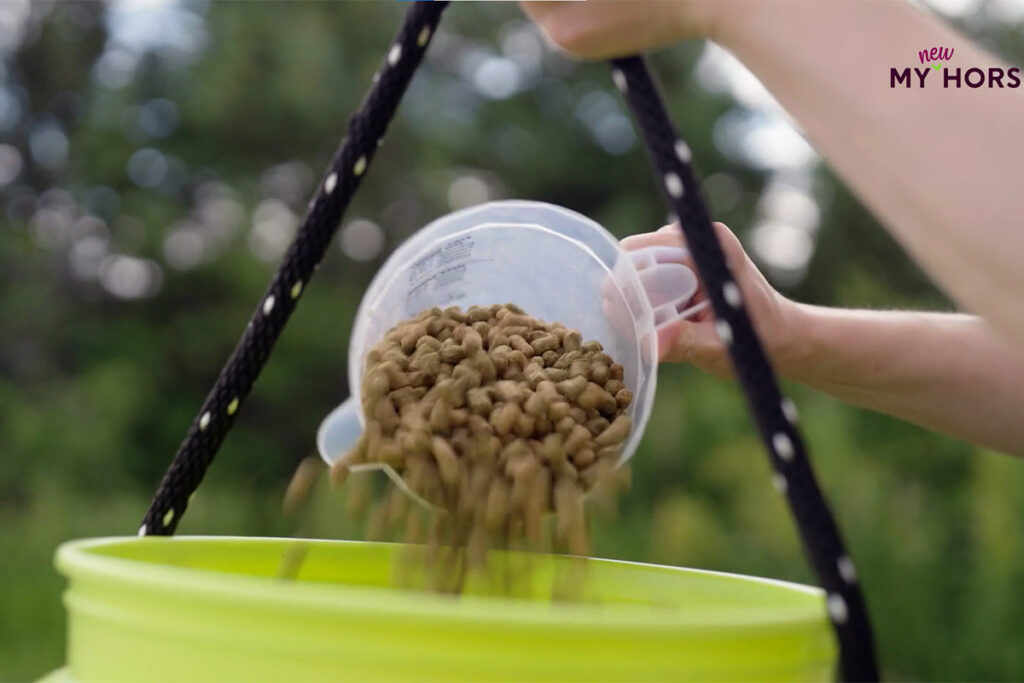You walk out to the barn and notice one of your horse’s legs looks puffy. What caused this to happen, and what should you do? Swelling in a horse’s leg can range from something mild and short-lived to a sign of a more serious problem. The key is knowing how to assess the situation and when to call your veterinarian.
Let’s take a closer look at the most common causes of leg swelling—from relatively harmless to more concerning—and what you can do about them.
1. Stocking Up
If your horse has been standing in a stall overnight or not moving around much, you might notice both hind legs (or sometimes all four) look slightly puffy below the knees or hocks. This is often just “stocking up,” or fluid accumulation from lack of circulation.
How to tell
- It usually affects both legs equally.
- Little to no heat, pain, or lameness.
- Swelling goes down after turnout or light exercise.
What to do
Hand-walk or turn your horse out so he can move around. Gentle exercise helps stimulate circulation and clear up the swelling. If your horse stocks up regularly, consider increasing turnout time and applying standing bandages (here’s a video showing you how) to the affected legs when your horse is stalled.
Related Reading: What Does it Mean if Your Horse Is ‘Stocking Up’?
2. A Knock, Bump, or Minor Injury
Sometimes swelling develops after your horse bangs a leg on a fence, kicks a wall, or takes a misstep. This kind of localized swelling is typically due to soft-tissue bruising or mild inflammation.
How to tell
- Swelling is usually in one leg.
- The leg might feel a little warm or tender.
- The horse may or may not look slightly “off.”
What to do
Cold-hose or ice the leg for 15-20 minutes to help reduce inflammation, and monitor it closely over the next day or two. If swelling doesn’t improve or worsens, or if your horse becomes lame, it’s time to call your vet to rule out a more serious injury.
3. Tendon or Ligament Strain

Swelling along the back of the leg (below the knee or hock) can signal an injury to the superficial or deep digital flexor tendons or the suspensory ligament. These injuries range from mild strains to serious tears.
How to tell
- Swelling is along the back of the cannon bone.
- The area feels firm or “corded” under your fingers.
- The horse might be noticeably lame.
What to do
Call your veterinarian promptly. Cold therapy, rest, and sometimes compression wraps can help initially, but a proper diagnosis (often via ultrasound) is crucial to determine the extent of the injury and create a rehab plan.
4. Joint Problems
Swelling around a joint (knee, hock, fetlock, or pastern) can come from arthritis, a sprain, or, in more serious cases, a joint infection.
How to tell
- Swelling is centered around a specific joint.
- There might be heat, pain, and lameness.
- The horse might resent flexing or bending the joint.
What to do
If your horse isn’t lame and the swelling is mild, cold-hosing and rest might be enough initially. But if there’s heat, pain, or significant lameness, contact your vet immediately. Infections in or near a joint can be life-threatening if not treated quickly.
5. Cellulitis or Lymphangitis
When a horse’s leg is suddenly very swollen, hot, and painful, it might be a case of cellulitis (a bacterial infection under the skin) or lymphangitis, which affects the lymphatic system. These can be medical emergencies.
How to tell
- One leg (often a hind) is extremely swollen, sometimes all the way to the stifle.
- The horse might be very lame or reluctant to move.
- The skin feels hot, tight, and painful to the touch.
- The horse might have a fever.
What to do
Call your veterinarian immediately. Prompt antibiotic treatment and anti-inflammatories are essential. Cold therapy and hand-walking (once advised by your vet) can help as the horse recovers, but this is not something to manage on your own.
When in Doubt, Call Your Vet
If you’re ever unsure why your horse’s leg is swollen or if the swelling comes with heat, pain, or lameness, it’s always smart to get your veterinarian involved. He or she can help determine what’s causing the problem and recommend the right treatment before things worsen. Here are some steps you can take in the meantime:
- Cold-hose for 15-20 minutes to reduce heat and inflammation.
- Check for wounds or punctures, because even small ones can lead to infection.
- Take your horse’s temperature, as a fever signals something systemic.
- Limit exercise until you know what’s going on.
- Note any changes in swelling, heat, or lameness from day to day.
Swelling in a horse’s leg isn’t always an emergency, but it’s never something to ignore. From harmless stocking up to serious infections, your job as a horse owner is to spot the signs early and take action. With attentive care and good communication with your vet, most horses recover well.
Related Reading:
Are you enjoying this content? Sign up for My New Horse’s FREE newsletter to get the latest horse owner info and fun facts delivered straight to your inbox!





